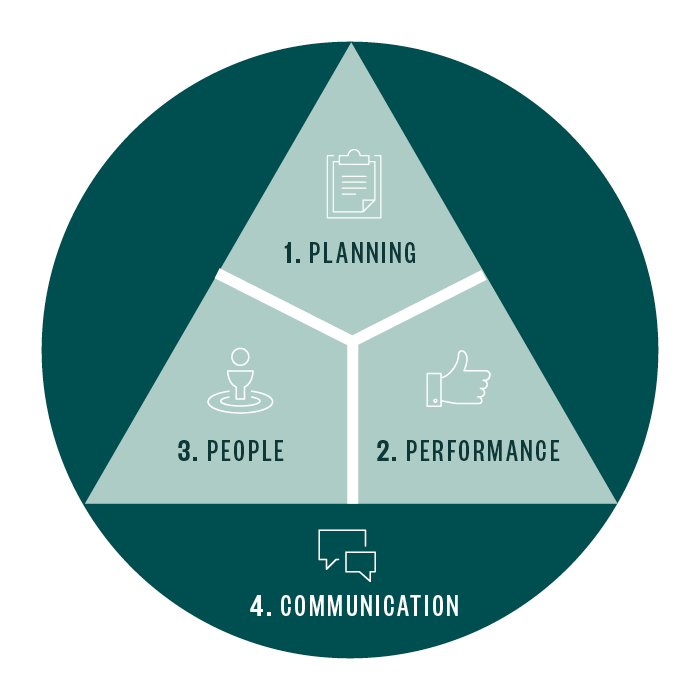
Many organizations achieve a high degree of success, but most don’t reach their full potential. So, what separates good organizations from great ones? Great organizations understand the importance of, and interrelationship between, planning, performance, people, and communication.
Below we outline how organizations can work to help enhance these key areas.
Prominent Challenges
All organizations face impediments to achieving optimal performance. And the next decade will bring unique challenges in addition to typical challenges companies face today, such as finding ways to increase revenue and reduce costs, growing a customer base, and staying ahead of regulatory changes.
Shifting workforce demographics and continuing low employee engagement, known as megatrends, already make it difficult for organizations to achieve their goals.
For instance, baby boomers are retiring at a rate faster than Generation X can replenish. As a result, it has become an employee’s market, making it more difficult and costly to attract and retain the right people.
At the same time, low employee engagement costs organizations throughout the United States billions of dollars a year in lost productivity.
Now, additional challenges arise from increased remote work setups during the COVID-19 pandemic and more employees wanting to continue to work from home.
These challenges are a reality. The question is: how can you overcome them?
The goal is peak performance which requires peak employee engagement. There are four attributes your organization needs to possess to achieve high employee engagement. They include:
- A clear plan for moving forward
- A focus on performance measurement
- A strategy for cultivating and compensating your people
- A commitment to communication
The key is achieving alignment between these attributes within your organization. No one component can stand alone; they must be interconnected to be effective.

Let’s take a closer look at each of these attributes.
What Is the Strategic Planning Process?
Every organization should be guided by a strategic plan, which defines a road map for moving from point A to point B.
The plan should reflect:
- A long-term vision to guide strategic decisions
- A thorough understanding of what got your organization to its current state
- A clear path to your desired future state
Take some time to consider how you got to where you are today and identify the drivers of your success. Take a look at your customer base and your competitors’ actions.
Engage your employees to assess the organization’s strengths, weaknesses, opportunities, and threats, known as a SWOT analysis. Including your staff is an integral part of the strategic planning process—doing so helps you build better buy-in on the execution of the plan.
Then, assess where you’re going by asking, ‘Where will we be in five years?’
Most organizations stop at the point of defining goals and objectives; however, strategic plans are also part action plan. What do you specifically need to do to execute on your strategies? Once in place, your plan can serve as a tool to help guide ongoing activities and provide a benchmark to measure performance.
Monitor Progress with Key Performance Indicators
To monitor performance against your plan, there should be key performance indicators (KPIs) in place. These indicators should be developed for each facet of your organization, and each one should tie back to your strategic goals and objectives.
Think of performance at three levels:
- Enterprise
- Department
- Individual
Most organizations have strong departmental metrics, but that isn’t enough. For success to become a reality, performance at each level is important and your employees need to understand how they can contribute to that success according to where they sit in the hierarchy.
For example, a strategic goal to expand business to a new region should be supported by departmental objectives for marketing, sales, operations, human resources, information technology, and legal that directly correlate to geographic expansion. Each of those departments needs to be aligned with that goal.
Similarly, individual objectives, sometimes referred to as management by objectives (MBOs), should define activities or initiatives for the upcoming time period that are linked to department goals, thereby creating alignment between all three levels.
How Can a Strategic Workforce Plan Help You Attract and Retain Talent?
To attract, retain, develop, and incentivize the workforce that’s needed to achieve your goals and objectives, you must determine what resources and competencies will be required at each level and in each facet of your organization.
How will you cultivate and compensate the workforce that you need to achieve your strategic goals? Here are some steps:
- Define your recruiting needs for entry-level and experienced personnel.
- Map career paths to support the progression of managerial and technical personnel. It’s critical that each type of employee is aware of and understands how to navigate their career path options, which increases retention.
- Develop compensation programs that create incentives for employees to accomplish goals and objectives. Leverage performance-based compensation to link pay to performance, and tie performance back to your strategic plan.
- Put training programs in place so employees can reach their top potential.
What Are the Steps in Communication Planning?
Planning, performance, and people form the cornerstones of high-performing organizations. However, you won’t achieve the engagement required to be a truly high-performing organization without communicating how these three elements work together.
Communication is the glue that binds these components and helps your employees understand how they individually and collectively contribute to the success of your organization.
Communication needs to be crisp, clear, structured, and regular. A solid communication schedule might include:
- An annual meeting covering the year’s strategic plan
- Quarterly, inclusive video conferences with financial results
- Monthly departmental updates
- Weekly team planning sessions
A regular communication rhythm keeps everyone in the know around how the organization is performing and what corrections need to be made to keep performance on the right track.
You want to avoid any year-end surprises, which is particularly important if you’re tying compensation to performance.
We’re Here to Help
To learn more about strengthening performance, people, and communication planning, contact your Moss Adams professional.